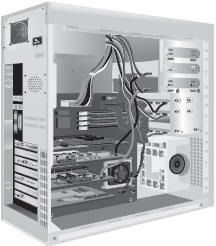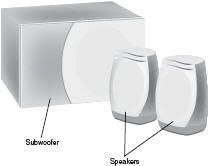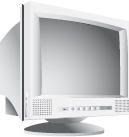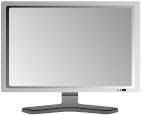Computer Hardware Basics
Computer hardware are those parts of your system you can actually see and touch. This includes your system unit and everything connected to it, including your monitor, keyboard, mouse, and printer.
We’ll take a close look at all the various pieces of hardware you can have in a computer system—including those parts you can’t always see because they’re built in to your system unit. So, if you’re curious about microprocessors and memory and modems and monitors, read on—this is for you!
PC’s System Unit
The most important piece of hardware in your computer system is the system unit. This is the big, ugly box that houses your disk drives and many other components. Most system units, like the one in Figure 1, stand straight up like a kind of tower—and are, in fact, called either tower or mini-tower PCs, depending on the size.
The back of the system unit typically is covered with all types of connectors. This is because all the other parts of your computer system connect to your system unit, and they all have to have a place to plug in.
And, because each component has its own unique type of connector, you end up with the assortment of jacks (called ports in the computer world) that you see in Figure 2.
And, as you’ve probably noticed, some PCs put some of these connectors on the front of the case— in addition to the back.
This makes it easier to connect portable devices, such as an iPod music player or a digital video camcorder, without having to muck about behind your PC. All the good stuff in your system unit is inside the case.
With most system units, you can remove the case to peek and poke around inside. To remove your system unit’s case, make sure the unit is unplugged, then look for some big screws or thumbscrews on either the side or back of the case. (Even better—read your PC’s instruction manual for instructions specific to your unit.)
With the screws loosened or removed, you should then be able to either slide off the entire case, or pop open the top or back. When you open the case on your system unit, as shown in Figure 3, you see all sorts of computer chips and circuit boards.
The really big board located at the base of the computer (to which everything else is plugged into) is called the motherboard, because it’s the “mother” for your microprocessor and memory chips, as well as for the other internal components that enable your system to function.
This motherboard contains several slots, into which you can plug additional boards (also called cards) that perform specific functions. Most PC motherboards contain six or more slots for add-on cards.
For example, a video card enables your motherboard to transmit video signals to your monitor. Other available cards enable you to add sound and modem/fax capabilities to your system.
Microprocessors
We’re not done looking at the system unit just yet. Buried somewhere on that big motherboard is a specific chip that controls your entire computer system. This chip is called a microprocessor or a central processing unit (CPU). The microprocessor is the brains inside your system.
It processes all the instructions necessary for your computer to perform its duties. The more powerful the microprocessor chip, the faster and more efficiently your system runs. Microprocessors carry out the various instructions that let your computer compute.
Every input and output device hooked up to a computer—the keyboard, printer, monitor, and so on—either issues or receives instructions that the microprocessor then processes. Your software programs also issue instructions that must be implemented by the microprocessor.
This chip truly is the workhorse of your system; it affects just about everything your computer does. Different computers have different types of microprocessor chips. Many IBMcompatible computers use chips manufactured by Intel. Some use Intel-compatible chips manufactured by AMD and other firms.
But all IBM-compatible computers that run the Windows operating system use Intel-compatible chips. In addition to having different chip manufacturers (and different chip families from the same manufacturer), you’ll also run into microprocessor chips that run at different speeds. CPU speed today is measured in gigahertz (GHz).
A CPU with a speed of 1GHz can run at one billion clock ticks per second! The bigger the gigahertz number, the faster the chip runs. If you’re still shopping for a new PC, look for one with the combination of a powerful microprocessor and a high clock speed for best performance. And the latest dual-core chips are even faster; you get the equivalent of two CPUs in one!
Computer Memory
Speaking of memory, before your CPU can process any instructions you give it, your instructions must be stored somewhere, in preparation for access by the microprocessor. These instructions—along with other data processed by your system—are temporarily held in the computer’s random access memory (RAM).
All computers have some amount of memory, which is created by a number of memory chips. The more memory that’s available in a machine, the more instructions and data that can be stored at one time. Memory is measured in terms of bytes. One byte is equal to approximately one character in a word processing document.
A unit equaling approximately one thousand bytes (1,024, to be exact) is called a kilobyte (KB), and a unit of approximately one thousand (1,024) kilobytes is called a megabyte (MB). A thousand megabytes is a gigabyte (GB).
Most computers today come with at least 512MB of memory, and it’s not uncommon to find machines with 2GB or more. To enable your computer to run as many programs as quickly as possible, you need as much memory installed in your system as it can accept—or that you can afford. (I’d say that 1GB is the bare minimum necessary to run a Windows Vista-based system.)
Extra memory can be added to a computer by installing a new memory module, which is as easy as plugging a “stick” directly into a slot on your system’s motherboard. If your computer doesn’t possess enough memory, its CPU must constantly retrieve data from permanent storage on its hard disk.
This method of data retrieval is slower than retrieving instructions and data from electronic memory. In fact, if your machine doesn’t have enough memory, some programs will run very slowly (or you might experience random system crashes), and other programs won’t run at all!
Hard Disk Drives
Another important physical component inside your system unit is the hard disk drive. The hard disk permanently stores all your important data. Some hard disks today can store up to 750 gigabytes of data—and even bigger hard disks are on the way. (Contrast this to your system’s random access memory, which stores only a few gigabytes of data, temporarily.)
A hard disk consists of numerous metallic platters. These platters store data magnetically. Special read/write heads realign magnetic particles on the platters, much like a recording head records data onto magnetic recording tape. Before data can be stored on any disk, including your system’s hard disk, that disk must first be formatted.
A disk that has not been formatted cannot accept any data. When you format a hard disk, your computer prepares each track and sector of the disk to accept and store data magnetically. Of course, when you buy a new PC, your hard disk is already formatted for you. (And, in most cases, your operating system and key programs also are preinstalled.)
CD-ROM Drives
Not all the storage on your PC is inside the system unit. Most PCs have a front-accessible CD-ROM drive, which lets you play audio CDs, install CDbased software programs, and (if the drive is enabled for recording) copy data from your PC’s hard drive to a blank CD-ROM disc. (The initials stand for compact disc–read-only memory, by the way.)
CD-ROM discs, such as the one in Figure 4, look just like the compact discs you play on your audio system.

They’re also similar in the way they store data (audio data in the case of regular CDs; computer data in the case of CD-ROMs). Information is encoded at a disc-manufacturing plant, using an industrial-grade laser.
This information takes the form of microscopic pits (representing the 1s and 0s of computer binary language) below the disc’s surface. Similar to hard and floppy disks, the information is arranged in a series of tracks and sectors, but the tracks are so close together that the disk surface is highly reflective.
Data is read from the CD-ROM via a drive that uses a consumer-grade laser. The laser beam follows the tracks of the disc and reads the pits, translating the data into a form your system can understand.
By the way, the ROM part of CD-ROM means that you can only read data from the disk; unlike normal hard disks and diskettes, you can’t write new data to a standard CD-ROM. However, most PCs include recordable (CD-R) and rewritable (CD-RW) drives that do let you write data to CDs—so you can use your CD drive just like a regular disk drive.
DVD Drives
Storage on a Disc Beyond the CD-ROM is the newer DVD medium. DVDs can contain up to 4.7GB of data (for a singlelayer disc) or 8.5GB of data (for a double-layer disc). Compared to 650–700MB of storage for a typical CD-ROM, this makes DVDs ideally suited for large applications or games that otherwise would require multiple CDs.
Similar to standard CD-ROMs, most DVDs are read-only—although all DVD drives can also read CD-ROMs. In addition, most DVD drives play full-length DVD movies, which turns your PC into a mini movie machine. And, just as there are recordable CDROM drives, you can also find recordable DVD drives, which let you record an entire movie on a single disc.
Some high-end PCs do the standard DVD one step better and utilize one of the new high-definition DVD formats—either Blu-ray or HD DVD. Both of these formats can store 25GB or more of data, more than enough to hold a high-definition movie.
That much storage for PC data may be overkill, however, especially given the initial pricing for these drives. Consider a Blu-ray or HD DVD drive (they’re incompatible with each other, by the way) only if you want to watch high-definition movies on your PC screen.
Keyboards
Computers receive data by reading it from disk, accepting it electronically over a modem, or receiving input directly from you, the user. You provide your input by way of what’s called, in general, an input device; the most common input device you use to talk to your computer is the keyboard.
A computer keyboard, similar to the one in Figure 5, looks and functions just like a typewriter keyboard, except that computer keyboards have a few more keys.
Some of these keys (such as the arrow, PgUp, PgDn, Home, and End keys) enable you to move around within a program or file.
Other keys provide access to special program features. When you press a key on your keyboard, it sends an electronic signal to your system unit that tells your machine what you want it to do.
Most keyboards that come with new PCs hook up via a cable to the back of your system unit. However, some manufacturers make wireless keyboards that connect to your system unit via radio signals—thus eliminating one cable from the back of your system.
Mice
It’s a funny name, but a necessary device. A computer mouse, like the one shown in Figure 6, is a small handheld device. Most mice consist of an oblong case with a roller underneath and two or three buttons on top.
When you move the mouse along a desktop, an onscreen pointer (called a cursor) moves in response. When you click (press and release) a mouse button, this motion initiates an action in your program.
Mice come in all shapes and sizes. Some have wires, and some are wireless. Some are relatively oval in shape, and others are all curvy to better fit in the palm of your hand.
Some have the typical roller ball underneath, and others use an optical sensor to determine where and how much you’re rolling. Some even have extra buttons that can be programmed for specific functions or a scroll wheel you can use to scroll through long documents or web pages.
Of course, a mouse is just one type of input device you can hook up to your PC. Trackballs, joysticks, game controllers, and pen pads all count as input devices, whether they work in conjunction with a mouse or replace it. You can use one of these alternative devices to replace your original mouse or (in some cases) to supplement it.
Modems
Many PC systems today still include a modem, which enables your computer to connect to telephone lines and transmit data to and from the Internet and commercial online services (such as America Online).
The word “modem” stands for “modulator-demodulator,” which is how digital data is sent over traditional analog phone lines. The data is “modulated” for transmittal, and “demodulated” upon receipt.
However, as more consumers opt for higher-speed broadband Internet connections (either via cable or DSL), there is less need for the traditional dialup modem. If you sign up for cable or DSL Internet service, your Internet service provider will provide you with an external broadband modem for their service. Most broadband modems connect to your PC either via USB or via an Ethernet connection.
Sound Cards and Speakers
Every PC comes with some sort of speaker system. While some older PCs had a speaker built into the system unit, systems today come with separate right and left speakers, sometimes accompanied by a subwoofer for better bass. (Figure 7 shows a typical right-left-subwoofer speaker system.)
You can even get so-called 5.1 surround sound speaker systems, with five satellite speakers (front and rear) and the “.1” subwoofer—great for listening to movie soundtracks or playing explosive-laden videogames.
All speaker systems are driven by a sound card that is installed inside your system unit. If you upgrade your speaker system, you also might need to upgrade your sound card accordingly.
Video Cards and Monitors
Operating a computer would be difficult if you didn’t constantly receive visual feedback showing you what your machine is doing. This vital function is provided by your computer’s monitor. The traditional CRT monitor, similar to the one shown in Figure 8, is a lot like a little television set.
Your microprocessor electronically transmits words and pictures (text and graphics, in PC lingo) to your monitor, in some approximation of how these visuals would appear on paper.
You view the monitor and respond according to what you see onscreen. The CRT monitor is going the way of the floppy disk, however, except in very lowend systems.
The preferred type of monitor in use today is the LCD monitor, such as the one shown in Figure 9, which provides a flat-screen display that saves a bit on desk space.
Even better, some LCD monitors come with a widescreen display that has the same 16:9 (or 16:10) aspect ratio used to display widescreen movies—which makes them ideal for viewing or editing movies on your PC.
You measure the size of a monitor by measuring from corner to corner, diagonally. The traditional CRT monitor is normally a 14" or 15" model; today’s LCD monitors start at 15" or so and run up to 21" or larger. Neither CRT or LCD monitors generate the images they display.
Instead, screen images are electronically crafted by a video card installed inside your system unit. To work correctly, both video card and monitor must be matched to display images of the same resolution. Resolution refers to the size of the images that can be displayed onscreen and is measured in pixels.
A pixel is a single dot on your screen; a full picture is composed of thousands of pixels. The higher the resolution, the sharper the resolution—which lets you display more (smaller) elements onscreen.
Resolution is expressed in numbers of pixels, in both the horizontal and vertical directions. Older video cards and monitors could only display 640×480 or 800×600 pixel resolution; you want a card/monitor combination that can display at least 1024×768 resolution—more, if you have a widescreen monitor.
For most users, the video card installed in their new PC works just fine. However, if you do a lot of heavy-duty gaming—especially with some of the newer graphics-intensive games—you may want to consider upgrading your video card to one with more on-board memory, to better reproduce those cutting-edge graphics.
And to display all of Windows Vista’s cutting-edge graphics, you’ll need a card with a separate graphics processing unit (GPU), which takes the graphics processing load off your PC’s main CPU. The more graphics processing power, the better your system will look.
Printers
Your monitor displays images in real time, but they’re fleeting. For permanent records of your work, you must add a printer to your system. Printers create hard copy output from your software programs. You can choose from various types of printers for your system, depending on your exact printing needs.
The two main types of printers today are laser and inkjet printers. Laser printers work much like copying machines, applying toner (powdered ink) to paper by using a small laser. Inkjet printers, on the other hand, shoot jets of ink to the paper’s surface to create the printed image.
Inkjet printers are typically a little lower priced than laser printers, although the price difference is shrinking. You also can choose from either black-and-white or color printers. Black-and-white printers are faster than color printers and better if you’re printing memos, letters, and other single-color documents.
Color printers, however, are great if you have kids, and they’re essential if you want to print pictures taken with a digital camera. By the way, there’s a type of “combination” printer available that combines a printer with a scanner and a fax machine. If you need all these devices (sometimes called a multifunction unit, or MFU) and are short on space, these are pretty good deals.







